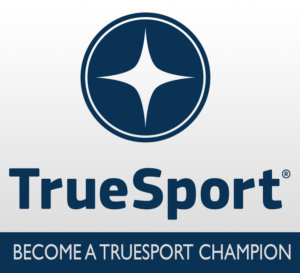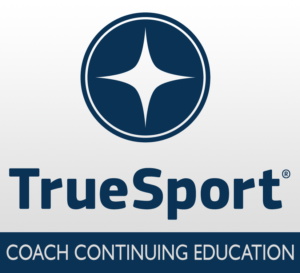3 Fun Customizable Noodle Bowls to Satisfy and Fuel Any Athlete
USA Cheer has partnered with TrueSport, to provide new educational tools to equip coaches, parents and young athletes with the resources to build life skills and core values for success in sports and in life. TrueSport, a movement by the U.S. Anti-Doping Agency, inspires athletes, coaches, parents, and administrators to change the culture of youth sport through active engagement and thoughtful curriculum based on cornerstone lessons of sportsmanship, character-building, and clean and healthy performance, while also creating leaders across communities through sport.
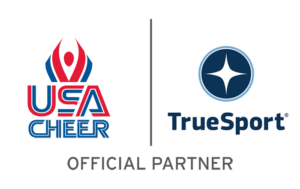
3 Fun Customizable Noodle Bowls to Satisfy and Fuel Any Athlete

TrueSport Expert Kristen Ziesmer
Noodle bowls are one of the most versatile options that busy parents can make to keep athletes well-fed and properly fueled—and most noodle bowls can be repurposed into leftovers for lunch or tweaked into entirely new meals for the next night!
Here, TrueSport Expert Kristen Ziesmer, a registered dietitian and board-certified specialist in sports dietetics, shares a few easy ways to make tasty noodle bowls that hit all the nutrition requirements of a growing athlete and taste good too!
Why make noodle bowls?
Before we get into the recipes, Ziesmer has a few reasons why noodle bowls are ideal for athletes and their families.
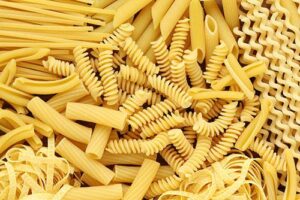 Noodle bowls offer easy portion control. “If your athlete had a double day of practices, they are going to need more calories in general, specifically carbohydrates and protein, to refill glycogen stores and kickstart recovery,” Ziesmer explains. “At the same time, you may not want a dinner that’s heavy on carbohydrates because you were at the office all day.” So while your athlete may need a double serving of noodles, you might opt to mix greens into your noodles and stick to a smaller serving of carbs. This, Ziesmer says, is a great way to let athletes eat what they need, without the risk that an athlete feels like they’re eating too much because it’s obvious you’re skimping on carbs.
Noodle bowls offer easy portion control. “If your athlete had a double day of practices, they are going to need more calories in general, specifically carbohydrates and protein, to refill glycogen stores and kickstart recovery,” Ziesmer explains. “At the same time, you may not want a dinner that’s heavy on carbohydrates because you were at the office all day.” So while your athlete may need a double serving of noodles, you might opt to mix greens into your noodles and stick to a smaller serving of carbs. This, Ziesmer says, is a great way to let athletes eat what they need, without the risk that an athlete feels like they’re eating too much because it’s obvious you’re skimping on carbs.- Noodle bowls are easy to customize for picky eaters. “The nice thing with noodle bowls is that if you have one athlete who’s vegan and one who eats meat, for example, you can provide options for both without preparing entirely different meals,” says Ziesmer. Some athletes may prefer cheese on pasta while others prefer chili flakes, so build-your-own noodle bowl meals cater to all types of eaters!
- Noodle bowls are easy to meal prep. Because you can prepare so much of the dish in advance, it’s easy to spend a couple of hours on meal prep once a week, then only a few minutes in the kitchen ahead of mealtime. You can pre-cook different meats, prepare certain sauces, and chop and prep vegetables for easy steaming.
- Noodle bowls teach athletes about healthy plates. Because noodles are so easy to customize, Ziesmer says, your athlete will be learning some basic cooking skills in the process. Even if they aren’t the one cooking the chicken, your athlete will gain an understanding of the different elements that make up a meal, making it easier for them to eventually navigate a training camp or college dining hall.
- Noodle bowls can be customized to avoid allergens. If your athlete is gluten-free, it’s easy to swap in a lentil pasta instead of whole wheat, says Ziesmer. Rice pasta is a fun way to experiment with new flavors as well.
- Noodle bowls are perfect for leftovers. Have extra spaghetti and sauce? You can toss that into a slow cooker with some broth and frozen vegetables and have a noodle soup for the next night! And don’t underestimate how tasty cold pasta can be at lunch the next day. Even meal prepping the basics—your proteins and vegetables—without seasoning can make it easier to mix and match your noodle, sauce, vegetable, and protein combos all week.
Noodle Bowl Recipes
Spaghetti Bar
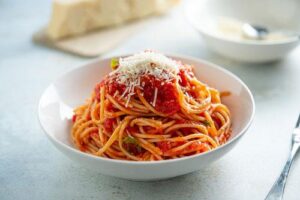 “My favorite option is the spaghetti bar,” says Ziesmer. It allows for easy customization and spaghetti is generally a good choice for even the pickiest athlete.
“My favorite option is the spaghetti bar,” says Ziesmer. It allows for easy customization and spaghetti is generally a good choice for even the pickiest athlete.
- Use whole wheat spaghetti instead of white for added fiber. For gluten-free or vegan athletes, lentil-based pasta adds protein while skipping gluten. You can also add zoodles—finely sliced or spiralized zucchini that’s gently sautéed—for a lighter option.
- Make your own sauce: Skip the pre-made sauces that are packed with sugar (check the ingredient label if you’re not sure) and instead, use pureed tomato, a dash of olive oil, some Italian seasoning, and your vegetables of choice. Adding chopped and sautéed onions and garlic adds flavor, while adding chopped spinach and fresh tomato gives your sauce greater nutrient density without changing the taste. (Chop spinach finely enough and your picky eater may not even notice!)
- Add protein. Chicken and ground beef are both common spaghetti additions. They can be added directly to the sauce or served on the side.
- Optional toppings like parmesan cheese can add extra calories for hungrier athletes, while fresh spinach can be a great middle-level ingredient on a plate (between the noodles and the sauce) to add bulk and nutrient density without extra calories.
Build Your Own Pasta Salad
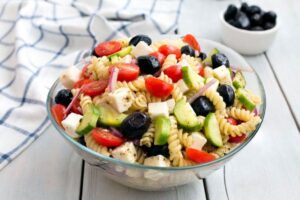 A cold pasta salad can be a great refreshing dinner option in the summer, or the perfect school lunch that kids can meal prep themselves according to taste.
A cold pasta salad can be a great refreshing dinner option in the summer, or the perfect school lunch that kids can meal prep themselves according to taste.
- Pick smaller pastas like shells, spirals, or macaroni noodles, again, opting for whole wheat or lentil based versus white.
- Create a dressing. If you have time, skip the bottled Italian dressing, which contains a lot of preservatives and fillers. Instead, mix your own simple vinaigrette in a mason jar with 1/2 cup olive oil, 1/4 cup red wine vinegar, 2 tablespoons of honey and 1 tablespoon of mustard.
- Chop your vegetables. For a classic Mediterranean inspired pasta salad, black olives, chopped red onion, tomato, and chopped up herbs and spinach or arugula turn the pasta into a tasty nutrient dense salad.
- Prep your protein. Depending on personal preferences, protein like chopped-up chicken breast, steamed shrimp, or even canned tuna or sardines are easy options.
- Add your extras. Crumbled feta cheese (or seasoned tofu for vegan athletes) and chickpeas can add flavor, fat, and fiber to a pasta dish.
- Toss it all together. Again, you can use whatever ratios make sense for each family member: If you’ve been working in the office all day, go light on the pasta and heavy on the vegetables. If your athlete is just getting home for practice and is ravenous, prioritize plenty of pasta and protein. Toss it all together with the dressing, making sure to shake it so that every piece gets a light coating of the dressing for the best flavor. You can enjoy it cold, or warm it up!
Go Asian-Inspired with Rice Noodles
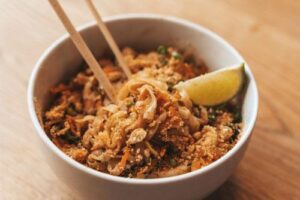 Setting up a do-it-yourself Pad Thai-inspired experience can be a great option for exploring new flavors, and since rice noodles are the base here, it’s ideal for gluten-free athletes who still need lots of carbohydrates. Remember, dishes like this are about experimenting with what tastes best to you, so play with the flavors!
Setting up a do-it-yourself Pad Thai-inspired experience can be a great option for exploring new flavors, and since rice noodles are the base here, it’s ideal for gluten-free athletes who still need lots of carbohydrates. Remember, dishes like this are about experimenting with what tastes best to you, so play with the flavors!
- Use brown rice noodles—these take less time to cook, so make sure to read the instructions on the package!
- Make a Pad Thai style-sauce. Combine equal parts creamy peanut butter, soy sauce (substitute coconut aminos or tamari if gluten free), rice vinegar, and a pinch of brown sugar plus a splash of fish sauce together (warm up peanut butter to make it easier to mix). You’ll need to play with the ratios to find the flavor that’s right for you. A quick note: Peanut butter isn’t a traditional ingredient in Pad Thai sauces, but many recipes call for it. You can test your preferences by leaving it out and sprinkling the finished dish with chopped nuts if you prefer!
- Choose your protein. Pad Thai is great for all types of eaters: Vegans can use chunks of tofu, vegetarians can scramble two eggs, and meat-eaters can choose between chicken and shrimp.
- Top it with some vegetables. Bean sprouts and broccoli sprouts add crunch and nutrient density to the dish, as do chopped up scallions.
- Toss it all together so the sauce evenly coats your noodles, protein, and vegetables.
- Squeeze some lime juice on top for a more lively flavor and your noodle bowl is ready to go! (It’s also tasty cold, so it’s an ideal leftover lunch.)
Takeaway
Noodle bowls are an easy, healthy, and fun way to fuel athletes. The combination of a complex carbohydrate pasta, lean protein, some healthy fats in a fun sauce, and some nutrient dense vegetables that can easily be integrated make noodle bowls the perfect go-to for families who struggle with picky eaters and lack of time to cook every night.
What is TrueSport?
The TrueSport Champion Network is a community of coaches, parents, program directors, and athletes who believe in the power of youth sport to build life skills and core values for success both on and off the field. Join TrueSport Champion Network to help promote the positive values of cheer, dance, and STUNT!
The TrueSport Coaching Education Program empowers coaches—the most significant influencers in young athletes’ lives—with a transformative learning opportunity to obtain the knowledge and resources to cultivate, champion, and uphold the rich promise and highest potential of sport.
Additional Training Modules from TrueSport
USA Cheer is proud to partner with USADA’s TrueSport® to bring relevant educational content to the Cheer and STUNT community in order to promote a positive youth sport experience. We are excited to provide access to TrueSport’s experts that take coaching beyond skills and help truly develop the overall athlete by building life skills and core values for success on and off the mat, sideline, field, and court.
Feel free to share these resources with your coaching staff, parents, or athletes!
About TrueSport
TrueSport®, a movement powered by the experience and values of the U.S. Anti-Doping Agency, champions the positive values and life lessons learned through youth sport. TrueSport inspires athletes, coaches, parents, and administrators to change the culture of youth sport through active engagement and thoughtful curriculum based on cornerstone lessons of sportsmanship, character-building, and clean and healthy performance, while also creating leaders across communities through sport.
For more expert-driven articles and materials, visit TrueSport’s comprehensive library of resources.
This content was reproduced in partnership with TrueSport. Any content copied or reproduced without TrueSport and the U.S. Anti-Doping Agency’s express written permission would be in violation of our copyright, and subject to legal recourse. To learn more or request permission to reproduce content, click here.


